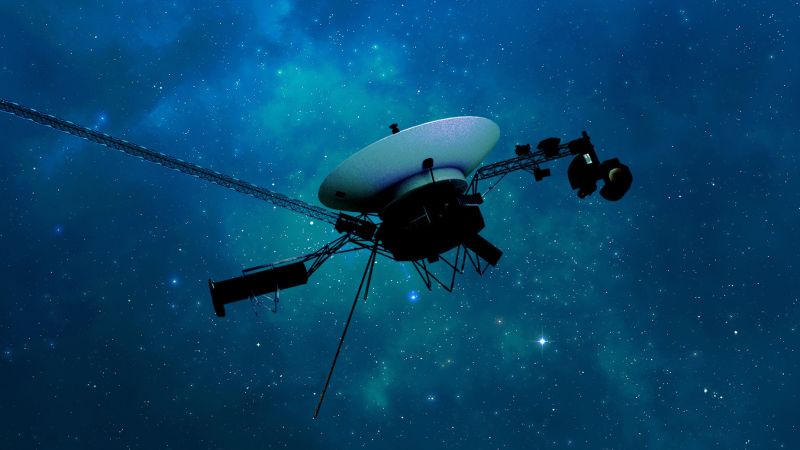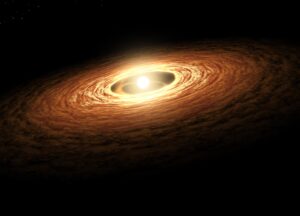NASA/JPL-Caltech
NASA’s Voyager 1 is shown in an artist’s illustration as the spacecraft travels through interstellar space, or the space between the stars.
Sign up for CNN’s Wonder Theory science newsletter. Explore the universe with news of fascinating discoveries, scientific breakthroughs and more.
CNN
—
The Voyager 1 spacecraft is sending back a steady stream of scientific data from uncharted territory for the first time since a computer error sidelined NASA’s historic mission seven months ago.
Currently the farthest spacecraft from Earth, Voyager 1 stopped communicating coherently with mission control in November 2023. The probe appeared to have fallen into a “Groundhog Day” scenario, with the Flight Data System’s Telemetry Modulation Unit sending back an indecipherable repetitive a pattern of code from billions of miles away.
A creative patch by Voyager’s mission team restored communication with the spacecraft, and engineering data began streaming back to mission control in April, informing the team of the spacecraft’s health and operational status.
However, data from Voyager 1’s four science instruments, which study plasma waves, magnetic fields and particles, remain elusive. This information is important to show scientists how particles and magnetic fields change as the probe flies farther.
On May 19, the Voyager team sent a command to the spacecraft to begin returning science data. Two of the instruments responded, but it took time to get data from the other two and the instruments required recalibration. All four instruments are now transmitting usable science data, according to an update shared by NASA on June 13.
Voyager 1’s flight data system is responsible for gathering information from the spacecraft’s science instruments and relating it to engineering data that reflect the health of the probe. Mission Control on Earth, located at NASA’s Jet Propulsion Laboratory (JPL) in Pasadena, California, receives this data in binary code, or a series of ones and zeros.
It took Voyager mission specialists time and some thinking to decode the spacecraft’s garbled code. But once they did, they found the cause of the problem: 3% of the flight data system’s memory was corrupted.
A single chip responsible for storing a portion of the system’s memory, including some of the computer’s software code, malfunctioned, and the loss of the chip’s code rendered Voyager 1’s science and engineering data unusable.
Since there is no way to repair the chip, the team stores the affected code from the chip elsewhere in the system’s memory. They couldn’t pinpoint a location large enough to hold all the code, so they split it into sections and stored it in different locations in the flight data system.
There are still small fixes needed to manage the effects of the original problem.
“Among other tasks, engineers will resynchronize the timing software in the spacecraft’s three on-board computers so they can execute commands at the right time,” according to the agency. “The team will also perform maintenance on the digital tape recorder that records some data for the plasma wave instrument that is sent to Earth twice a year.
(Most of the Voyagers’ science data is sent directly to Earth and not recorded.)”
Meanwhile, Voyager 1 is back to what it does best: sharing insights from uncharted space territory.
The spacecraft is currently about 15 billion miles (24 billion kilometers) from Earth, while its sister vehicle, Voyager 2, has traveled more than 12 billion miles (20 billion kilometers) from Earth. The twin probes took off over the course of weeks in 1977, and after initially flying by Jupiter, Saturn, Uranus and Neptune, their missions have been extended to 46 years and counting.
Both are in interstellar space and are the only spacecraft that operate outside the heliosphere, the solar bubble of magnetic fields and particles that extends far beyond Pluto’s orbit.
As the only extensions of humanity outside the protective bubble of the heliosphere, the two probes are alone during their spacewalks as they travel in different directions.
Imagine the planets of Earth’s solar system as existing on a single plane. Voyager 1’s trajectory took it up and out of the plane after passing Saturn, while Voyager 2 passed over the top of Neptune and moved down and out of the plane, Suzanne Dodd, Voyager project manager at JPL, told CNN earlier.
The information gathered by these long-lived probes, the only two spacecraft to directly sample interstellar space with their instruments, helps scientists learn about the comet-like shape of the heliosphere and how it shields Earth from energized particles and radiation in interstellar space.
Over time, both spacecraft encountered unexpected problems and outages, including a seven-month period in 2020 when Voyager 2 was unable to communicate with Earth. In August 2023, the mission team used a long-shot “shout” technique to restore communications with Voyager 2 after a command inadvertently pointed the spacecraft’s antenna in the wrong direction.
“We never know for sure what’s going to happen with the Voyagers, but it constantly amazes me when they just keep going,” Dodd said in April.



